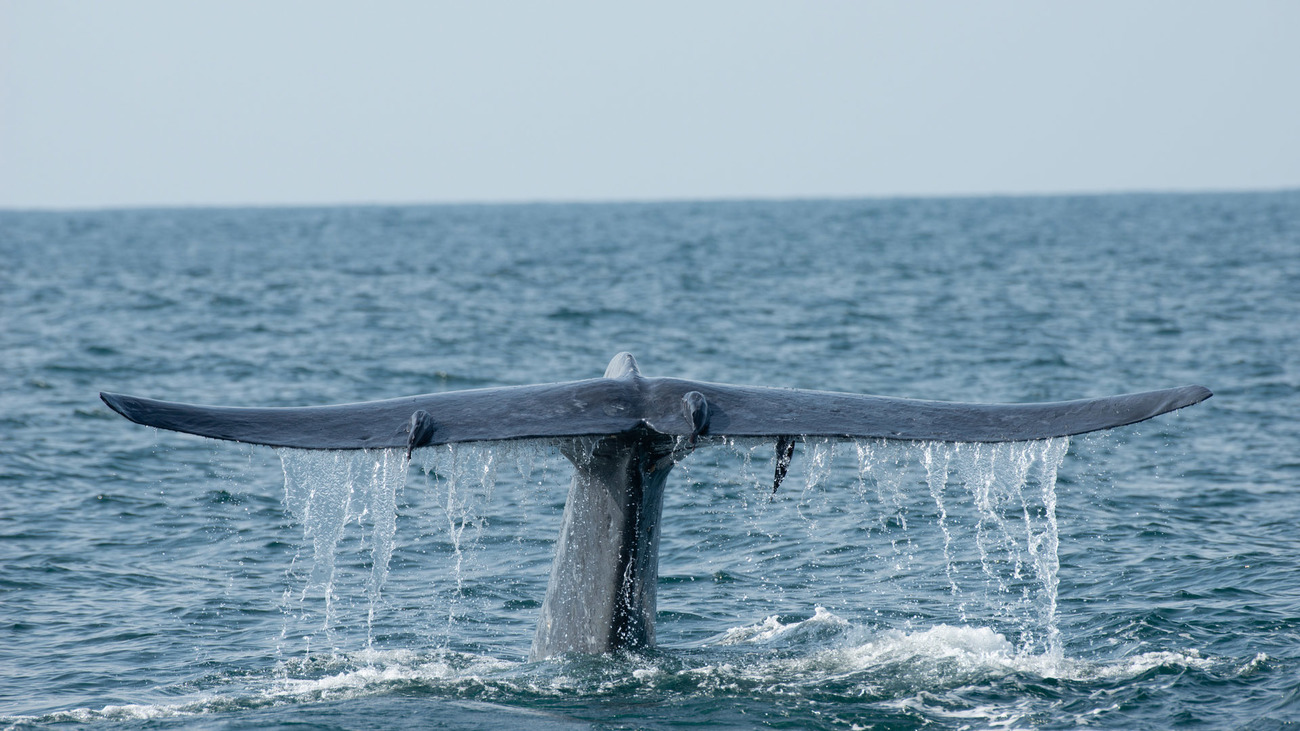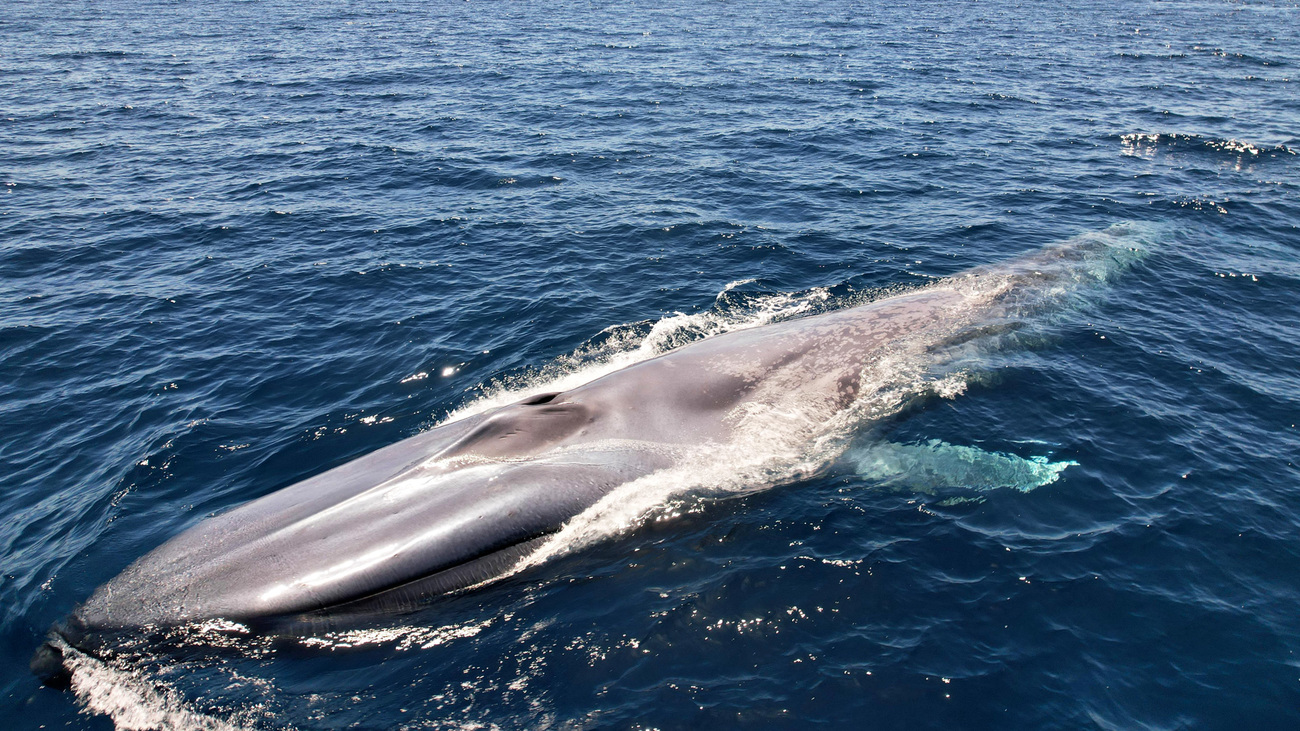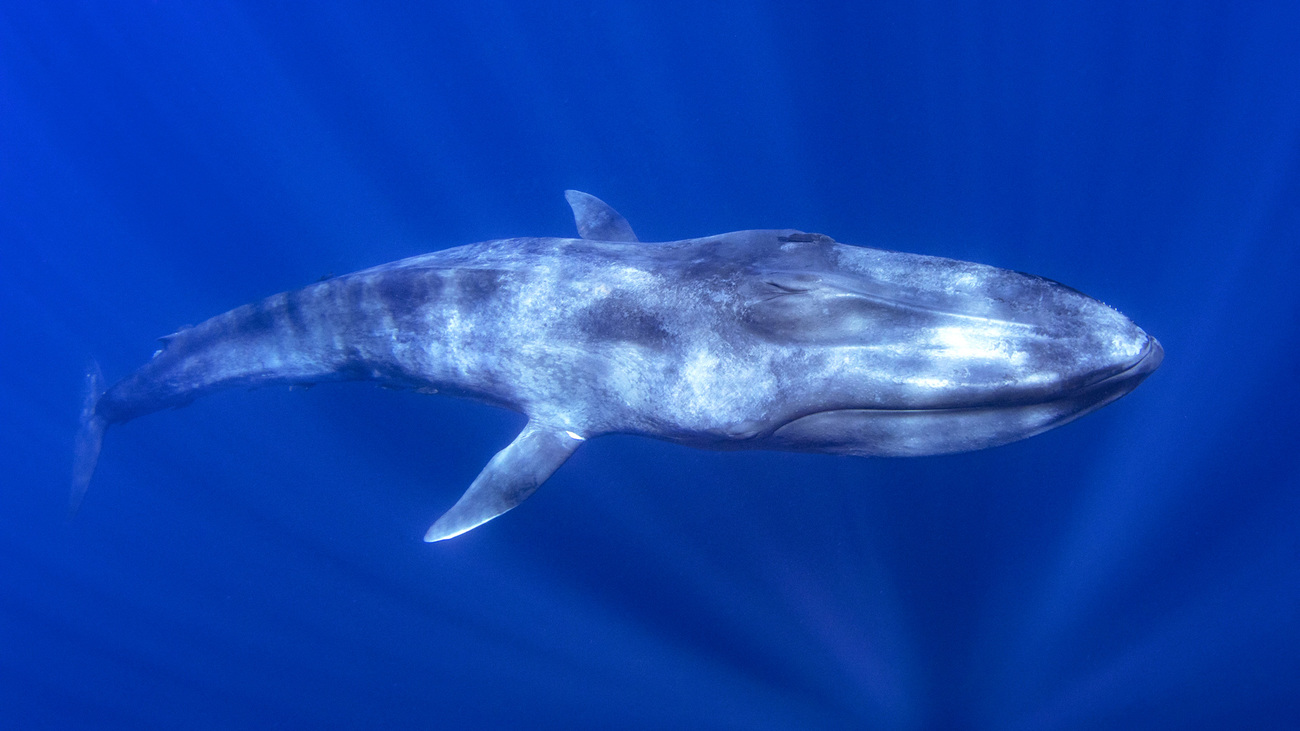Blue whales
Blue whales are the largest animals on Earth, reaching lengths of over 30 meters. Their heart alone is about the size of a small car and weighs around 180 kilograms.
They have long, streamlined bodies with blue-grey skin, which lends the species its name. A blue whale’s enormous mouth contains rows of baleen plates, which hang from the roof of their mouth and act like a sieve while they’re feeding.
Blue whales primarily feed on tiny, shrimp-like organisms called krill. Some of the biggest blue whales ingest six tonnes of krill each day. During feeding, they open their mouths wide and engulf large volumes of water and krill. Then they use their baleen to filter out the water, swallowing the krill.
While blue whales are generally solitary or found in small groups, during mating and breeding seasons, they tend to form temporary groups. They’re some of the loudest animals on the planet, emitting pulses, groans, and moans to communicate with each other. With the right oceanic conditions, other whales can hear them up to 1600 kilometers away.
Blue whales play a critical role in marine ecosystems and the climate. As ecosystem engineers, they control the population of krill, preventing imbalances in the food chain and contributing to the stability of the food web.
On a cultural level, blue whales inspire awe and wonder, connecting people to the natural world and driving marine conservation initiatives. They also serve as an indicator of ocean health—their thriving populations reflect a healthy ecosystem, while a decline signals environmental issues.
What is a blue whale’s scientific name?
The scientific name for the blue whale is Balaenoptera musculus. The genus name, Balaenoptera, means ‘winged whale’ in Latin. The species name musculus, could either mean ‘muscle’ or be a diminutive form of ‘mouse’, a pun left behind by the scientist who named blue whales.
Are blue whales endangered?
Sadly, blue whales are currently classified as endangered by the IUCN Red List. However, their numbers are increasing. Some subspecies of blue whales face a larger threat and are listed as critically endangered, including Antarctic blue whales.
Primary threats blue whales face include commercial whaling, noise pollution, ship strikes, and climate change, which affects their food sources and habitats.
Where do blue whales live?
Blue whales can be found in all oceans except in the Arctic. Known for their impressive migratory patterns, blue whales travel massive distances each year. They migrate because they prefer to feed in cooler, nutrient-rich waters and breed in warmer, tropical areas.
There are many subspecies of blue whales named for the areas in which they live. For example, the Antarctic blue whale is found in waters around the Antarctic, though they are known to travel north to the Indian Ocean and the eastern tropical Pacific.
Threats
Blue whales face multiple threats, placing them on the endangered species list. These threats include commercial whaling, noise pollution, ship strikes, and climate change.

Whaling
It sounds like an outdated practice, but commercial whaling—the hunting and killing of whales to sell their meat and blubber—still happens today. Around 1,000 whales are killed each year. And it’s a painful way to go, with a 2023 study finding that 40% of whales killed during whaling season suffered slow and painful deaths.
While there is a global ban on commercial whaling and the international trade of whale products, countries including Iceland, Japan, and Norway continue hunting blue whales commercially.
Noise pollution
Trying to communicate with fellow whales in an ocean filled with commercial ships is like a human trying to be heard over a loud party—it’s not easy. Since the 1950s, underwater noise has doubled every decade, severely impeding whales’ only communication channel.
Thankfully, this is a far easier problem to solve than other forms of pollution. Slower ship speeds are a simple solution to make the ocean quieter and more liveable for blue whales.
Ship strikes
Collisions with ships, or ship strikes, are one of the biggest threats facing blue whales today. This happens when shipping lanes are constructed in areas where whales are found. Due to their huge size and low agility, blue whales are very vulnerable to ship strikes.
One particular subspecies of blue whale found off the coast of Sri Lanka does not migrate to feed and breed, placing them right in one of the ocean’s busiest shipping lanes year round. More than 200 ships pass through this area every single day, fueling high rates of blue whale ship strikes.
Entanglement
Discarded commercial fishing material poses a huge problem for marine life. 2% of all fishing gear used worldwide ends up polluting oceans. The fishing rope and nets discarded into the ocean in just one year could circle the Earth more than 18 times.
Blue whales easily become entangled in fishing ropes or nets, and without arms and hands, it’s nearly impossible for them to free themselves. Experts estimate that hundreds of thousands of whales die every year due to entanglement, because it causes injury and malnutrition.
FAQs
How big is a blue whale?
Blue whales are huge, often weighing over 200,000 kilograms. Just its tongue alone weighs more than an elephant, and its blood vessels are so wide a human could swim through them.
Some subspecies tend to be heavier than others, due to different habitat conditions. Antarctic blue whales are, on average, heavier than the typical blue whale.
Even at birth, blue whales are giant, clocking in at 2,200-2,700 kilograms. For the six to seven months that baby blue whales breastfeed from their mothers, they gain around 90 kilograms every day.
How long is a blue whale?
The longest blue whales are about 33 meters long.
How big is a blue whale’s heart?
The heart of a blue whale is about the size of a golf cart and weighs around 180 kilograms.
How big is a blue whale’s eye?
While blue whales have small eyes in relation to the rest of their bodies, their eyeball is about the size of a grapefruit. They have weak eyesight, relying primarily on their other senses to survive in the ocean.
Is the blue whale the largest animal ever?
Yes, the blue whale is the largest animal to have ever lived on Earth. One hundred humans could fit in just its mouth.

What do blue whales eat?
Blue whales subsist on a diet of krill—tiny, shrimp-like organisms that float through the ocean. Krill form massive swarms, which whales suck into their mouths; they then use their baleen plates to filter out the water and trap the tiny creatures. Each day, a blue whale can consume 4 tonnes or more of krill.
How long do blue whales live?
Blue whales live for about 80 to 90 years in the ocean, though human activity has significantly endangered their lifespans.
Do blue whales have predators?
Blue whales are one of the few animals on Earth to have only one predator—humans. They’re far too big to be preyed upon by other marine creatures. While orcas have been seen attacking blue whales, it’s uncommon.
Humans have significantly endangered the whale population, primarily through whaling and commercial fishing. Aggressive hunting in the early 1900s by whalers seeking blubber to use as oil nearly drove blue whales to extinction. In the 1960s, laws were introduced to prevent the trading of whale products, but that hasn’t stopped all commercial whaling.
Do blue whales have teeth?
While blue whales don’t have teeth like other mammals do, they have baleen, bristles hanging from the roofs of their mouths that evolved from teeth.
Whales take in large amounts of water, which they then filter through their baleen. Krill get trapped in the baleen, the water is expelled, and the whales ingest the krill.
How fast can a blue whale swim?
Most of the time, blue whales cruise gracefully through the water at about 8 kilometers per hour. However, when they’re agitated, they can accelerate for short bursts of time, up to 48 kilometers per hour.
How do blue whales sleep?
Blue whales sleep by shutting down only half of their brain—the other half stays awake and is in charge of making sure they remember to go to the surface and take a breath. After a while, they switch sides so each half of the brain gets enough rest.
How loud is a blue whale?
Blue whales make a lot of noise—in fact, they are the loudest animals on the planet. Through groans, moans, and pulses, blue whales communicate with each other over long distances. In good conditions, it’s believed that they can ‘talk’ to each other from over 1600 kilometers away.
Scientists also believe that whales use noises to help navigate their way through the ocean's dark depths with sonar.
How long are blue whales pregnant?
Blue whales gestate for around 10 to 12 months. While pregnant, blue whales migrate to give birth in warmer waters near the equator. Females give birth to a single calf, which is typically around 8 meters long. The calves nurse for around five to seven months and gain about 90 kilograms daily during this time.
Why are blue whales endangered?
Sadly, blue whales face many threats, making them an endangered species. Commercial whaling and noise pollution are two of the biggest threats to blue whales. Blue whales also face rising sea levels, marine pollution, and ship strikes.
How many blue whales are there?
The IUCN estimates that there are between 5,000 and 15,000 mature blue whales alive in the ocean right now. Their population seems to be increasing.
Our work
IFAW works to protect whales, marine life, and habitats around the world. While blue whale populations are slowly increasing, they are still an endangered species and face myriad threats from harmful human activities. One of our biggest projects focuses on the major shipping lane off the southern coast of Sri Lanka, which crosses right through critical blue whale habitat. This creates a very high risk of ship collisions with these endangered whales, as this is one of the busiest ship routes in the world. Scientific studies show that a small shift in the current international shipping lane by just 15 nautical miles to the south would reduce the risk of ship strikes with blue whales by a staggering 95%.
We’ve already seen great success. IFAW worked with the world’s largest shipping and logistics conglomerate, MSC Group, to reroute some of their ships to protect these whales off the coast of Sri Lanka, and many other shipping companies are making the same commitment.
Our Blue Speeds campaign aims to implement a 10% reduction in current shipping speeds across the board. It may not sound like much, but that small change could reduce underwater noise from shipping by around 40%, the risk of collisions with whales by 50% and—as a bonus—greenhouse gas emissions by 13% globally.

How can you help?
With the help of our extended network, we’ve already been able to save the lives of hundreds of blue whales. Things are looking up—but there’s still much more work to do.